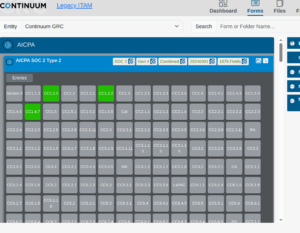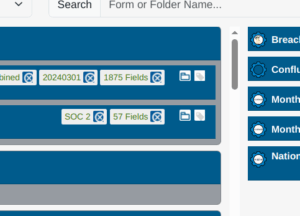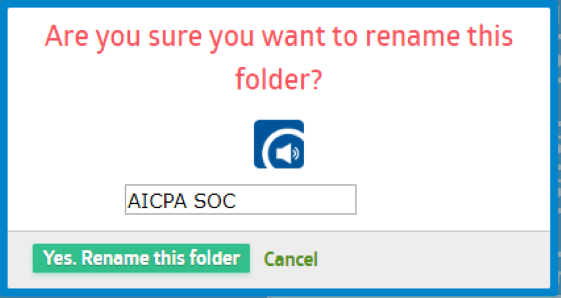Form Manager
Table of Contents
ToggleOverview
Forms are critical tools for capturing and validating an organization’s compliance data. Many organizations and agencies have used spreadsheets and free-standing documents to capture compliance information. These lacked an excellent way to aggregate and report on data and are difficult to keep organized.
The IT Audit Machine’s Form Manager is where those forms are kept within the system, and it has the functionality and flexibility needed to craft powerful forms for gathering and interacting with the data your organization needs.
In this section of the guide, we will start by taking a high-level view of the Form Manager and the various form management capabilities directly accessible from there. Subsequent pages will go into further detail on creating forms with the Form Builder, some of the Advanced Form Management features, and finally, how to interact with the data entries captured via the Entry Manager.
Form Manager View
When you first navigate to the Form Manager by selecting the icon on the left-most left in the main menu bar, you will be presented with a high-level view of their available folders and forms. Folders are in dark blue on the left of the screen, allowing forms to be organized together in whatever makes sense for your organization.
Typically, forms are organized by the standard they support. However, a folder is simply a container for forms and can be organized differently to support your organization's needs. These folders use an accordion-style interface, meaning they can be expanded and contracted by clicking on the dark blue bar representing the folder.
On the right, by default, it displays any available forms that have not yet been assigned to a folder. The right side also displays the results when searching for a form. Whether a form is in a folder or by itself, it acts as an accordion interface. Clicking on the bar representing a form will display or hide the various icons used to access the powerful array of management and editing options available for a form. Unlike folders, forms may be different colors depending on their status in the system.
See the images below to view how the folders and forms expand when interacted with.
Clicking on a name expands that folder to view the available forms within it and the icons to edit and delete it.
Clicking on a Form, whether in a folder or one of the unorganized files on the right, will display the options for managing or editing the Form.
For some forms, a set of tiles representing any control groups in the form will also be displayed. We will cover these later.
As discussed, from this initial view, you can find and work with a specific form, create a new form, or organize the forms into Folders. Many options for working with a form can also be selected directly from the Form Manager page, though some are only available when editing or building a form. Let us explore most of the capabilities accessed directly from the main Form Manager page: finding a specific form, standard form management options, and working with folders.
Finding a Specific Form
As you work with the IT Audit Machine, your organization will likely accumulate forms. ITAM makes it easy to find and organize your forms, so you can quickly find the ones you need when you need them.
Searching and Filtering the Forms List
A search box is provided at the top left corner of the Form Manager so users can easily search and filter the list of forms.
The search box becomes active when you select or click it with the mouse. When activated, the search box expands and displays three search option tabs for searching the available forms:
- form tag
- form elements
- form title
Note: When searching, the form title is the default option.
A search is performed when you select a search option, enter a search term, and click the Go button. The results are displayed instantly on the right side of the page, and the search terms are highlighted.
All searches are case-insensitive and allow for partial word matches.
Search Options
|
Search Option |
Description |
|---|---|
|
Form Tags |
The Form Tags search option searches the tags associated with each form for the term used in the search. For more information on tags, see the section titled Tagging Forms below. |
|
Form Title |
The Form Title search option searches the titles of the forms in your collection for the term used in the search. |
|
Form Elements |
The Form Elements search option searches within the available forms for elements that contain the search term. This search will provide an additional option in the search results to display the text of the elements that match the search term and link to the related form.
Form Elements Search Results Note: To toggle the display of the Field-level results, click the red plus/minus symbol on the resulting forms. |
Sorting Forms
The forms list may also be sorted based on predefined conditions. Click the “Sort By” drop-down control at the Form Manager's top right corner and select the Sort Option you prefer. Each Sort Option appears twice, once in Ascending order and once in Descending order.
Sort Options
|
Sort Option |
Description |
|---|---|
|
Date Created |
Sorts by the date the form was initially created. |
|
Form Title |
Sorts by the title of the form. |
|
Form Tags |
Sorts by the tags associated with each form. |
|
Today’s Entries |
Sorts by which forms have entries from the current day. |
|
Total Entries |
Sorts by which forms have the most or least total entries. |
Standard Form Management
The ITAM Form Manager features several tools for working with and managing a form. This section will cover many of those. For specifics on creating or editing the questions on a form, see the Form Builder.
Note: Unless otherwise specified, most form management icons are toggled between being displayed and hidden when you click on a form's name in the Form Manager.
Create or Edit a Form
The Create New Form Button, located at the top right of the Form Manager, initiates the creation of a new form.
Remember, form icons are displayed and hidden by clicking on the form's name.
If you attempt to Edit a form for which user entries have already been created a dialog will appear notifying you that doing so will delete any User Data associated with the form.
Clicking the Yes, Proceed button will bring you to the Form Builder, where you can edit the form. If you edit the form and save your changes, the associated User Data will be deleted.
Note: User Data will be downloaded automatically before deletion.
Whether you are creating a new form or editing an existing one, the Form Builder tool will appear. This tool gives you access to the rich toolset for building and editing forms in the ITAM Admin Portal. For more information on the tools and functionality, see the Form Builder section of this guide.
Tagging Forms
If you manage many forms across one or more organizations, you will find the "Tag" feature of the ITAM Forms Manager handy. Tagging forms allow you to dynamically create categories and groups of forms based on the tag values assigned to them. Combined with the powerful form search capability, it will enable you to quickly find all forms you have tagged with a particular value, creating a loose association of forms that are easy to find when needed.
To create a form "Tag," click the tag icon on the right side of the form list entry.
This will launch the Enter a Tag Name popup form.
To assign multiple "Tags" at once, input all the tag names and separate them with commas.
A Tag may be deleted by clicking on the blue X icon displayed on the tag name on the form.
Enable or Disable a Form
While developing your forms, it is standard practice to leave them disabled to prevent users from accidentally trying to interact with a form in progress. Once you have completed your development and are ready to accept new entries, you can activate the form by clicking the Enable button.
Note in the sample image above that when a form has been disabled, the form name appears as struck through with a single line, and the Enable button is displayed.
It may occasionally be necessary to close or disable a form temporarily and not accept any new entries. Fortunately, this can be easily accomplished using the Disable icon. Select the form to be disabled, then click the Disable button at the bottom right of the form entry.
A popup window will allow you to modify the status message for the disabled form. When a user attempts to use the disabled form, the form's status message will be displayed instead of the form fields. Customizing the message for each form is a good practice to give your users a clear understanding of why the form is unavailable.
Personalized disabled/inactive status messages for each form will be more informative and useful to users if they explain the reason for the form's inability and provide a projected reactivation time.
Click the green Yes, Disable this form button to confirm.
This feature is most commonly used for time-sensitive forms such as event registrations, job applications, etc.
It is essential to understand that disabling a form does not have the same function as deleting a form. Disabling a form does not result in data deletion from the database. It only makes the form inaccessible for data entry.
Changing a Form’s Theme
When you create a new form, a theme will be assigned. A theme is a set of Cascading Style Sheets (CSS) attributes to control the look and feel of your form (colors, backgrounds, fonts, logo, etc.). The “Lazarus Alliance Bold” theme is assigned to your form by default. You can change the theme by clicking the “Theme” link and selecting a new theme from the drop-down list.
There are built-in themes available, or you can create your theme by choosing the Create New Theme option. For more information about building your theme, see the Theme Manager section of this Guide.
Duplicating a Form
Duplicating a form will create an exact copy of the form, including all of the settings (notifications, payment, theme). However, it doesn’t copy the entries that were in the original form. The new copy will have no entries. If you need to create many forms with similar fields, it’s best to create a master form containing all the standard fields. Every time you need to make a similar form, you can duplicate your master form and then modify it further. This way, you won’t need to add all the fields from scratch each time.
Deleting a Form
Occasionally, a form may need to be deleted. To do so, click the Delete icon under the form.
Deleting a form will also delete all associated data entries (including file uploads). There is no trash/recycle bin to restore your forms from your admin panel quickly, so use caution.
Cancelling a Form
Depending on how your organization is set up in ITAM, you may or may not have other entities subscribed to your forms. Once an entity is subscribed to a form, there may come a time when it is necessary to cancel their subscription. This is done through the Cancellation Manager, accessed via the Cancel Membership icon under the form. If an entity previously subscribes to a form requiring payment, this subscription will persist until you cancel your membership.
Clicking on the Cancel Icon displays the Cancellation Manager, which allows an Administrative User to select the organization/entity they wish to remove from the form and cancel their membership.
Setting Payment Options for a Form
If your organization has clients who access your forms and require payment from those clients to use a form, the Payment Settings interface will allow you to define those options. This interface is accessed via the Payment Settings Icon below the form.
The Payment Settings screen lets you configure the Merchant Settings, Payment Options, and the Price.
Advanced Form Management
The IT Audit Machine also has additional advanced options that allow entities to automate, fine-tune, and empower their forms, taking them to the next level.
For more information about these advanced capabilities, see this guide's Advanced Form Management section.
Managing Form Entries
The final form management icon on the Form Manager page is the View button, which is available above the form when the icons for a form are displayed. This capability lets you manage User data entered on a form. See the User Entry Management section of this Guide for more details.
Folder Management
In addition to the various options for working with forms, the IT Audit Machine also has tools for working with folders. Folders are used to organize your forms; they help you quickly find the forms you need. This organization becomes more critical the more forms you interact with in ITAM.
Folder Creation
Folders are created by moving a form into a new folder. To do this, select the Folder icon above the form you want to move into the new folder.
This will pop up the Move Form dialog with options to move to an existing folder or create a new one. Enter the name of the folder you wish to make in the text box provided and click the Create & Move button.
As noted above, you can also use the Folder icon on a form to move a form between existing folders.
Rename Folder
Folders are renamed using the Rename icon above a folder’s name when expanded.
Simply edit the name displayed in the Rename Folder dialog and click on the Yes. Rename this folder button.
Delete Folder
When expanded, folders are deleted using the Delete icon above a folder’s name.
Clicking on this icon will display the Delete Confirmation dialog.
To complete the folder deletion, click on the green Yes. Delete this folder button.
Warning: Deleting a folder is a permanent action that cannot be undone. The forms in the folder will not be deleted but moved out of the folder and displayed with the other unorganized forms.













